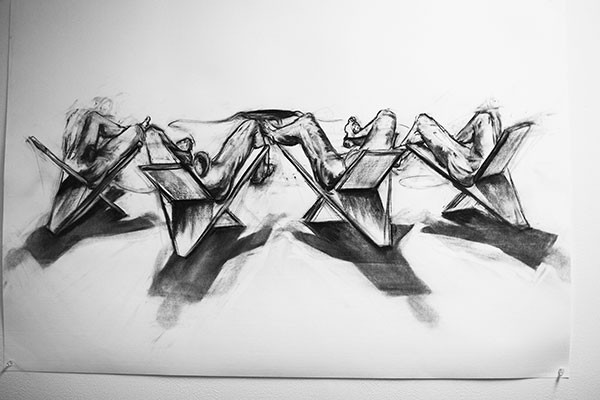The Dunedin School of Art and the University of Otago Law Faculty have collaborated to bring a twice yearly art exhibition to the corridors of the Richardson Building on the Otago campus. Initiated originally by Peter Stupples, the exhibitions are curated by Marion Wassenaar and have been running for seven years.
The current exhibition, which runs across three floors of the Law Faculty in the Richardson Building, has had many of its viewers talking, and there is no doubt that the three artists, Victoria Stevens, Brittany Waszczak and Kiri Mitchell, intended to engage the public in a discussion.
Victoria Stevens describes herself as “a mature, white, middle-class female”. Stevens has presented a triptych of images, “Clitoris Allsorts I, II, and III” (2014) — each image is an embroidery on paper depicting a synchronised swimmer’s legs above the water.
Brittany Waszczak, in a feminist critique, seeks to convey the notion of abjection through her work. She has been influenced by Julia Kristeva’s 1982 work, Powers of Horror, as well as Jacques Rancière’s, Aesthetic Revolution and Its Outcomes (2002), which led her to conclude that while beauty may have some rational properties such as order, symmetry and proportion, it is an attribute not explained by reason alone.
Waszczak informs us that the embellishment of the merkin on the stained and outdated male underwear, from her series “Skid Row”, is a form of ironic pretence that comments on anxiety in a complex situation. Through media and advertising, the pressures imposed on young women about how they look have become pathological as a new generation of young men are repulsed by the au naturel.
Stevens and Waszczak have given the viewer food for thought, but it is Kiri Mitchell’s body of work that has many viewers commenting on this exhibition. Mitchell has constructed scenarios that critique how men and women interact, exploring the sexual politics of these exchanges in a bizarre environment where women are represented both as female archetypes and anonymous birthing sacks. These scenarios are presented in dioramas, utilising sets from the creation of a stop-motion film that illustrates the grey area of sexual politics where there is no clear villain or victim, the place where desires and needs collide and compromises are made. The film engages with humour and pathos and has a horror movie undertone where the fate of the male characters is precarious. The work explores and references the works of Michel Foucault and Barbara Creed.
The female body as a resource is depicted at its most extreme through the collection of menstrual blood, which is used to activate the growth of an external birthing sack. The sacks are made available to the male characters as places to take comfort and pleasure. The preparation and maintenance of the sacks is a messy affair conducted behind industrial closed doors.
With a strong drawing practice, Mitchell uses preparatory charcoal sketches to develop narrative in the stop-motion film, and these are displayed alongside the dioramas and throughout the floors of the exhibition.
This exhibition is thought provoking. Whether you are comfortable with the feminist, abjection and gender issues raised is up to you, but this exhibition will give you something to think about after you leave.



